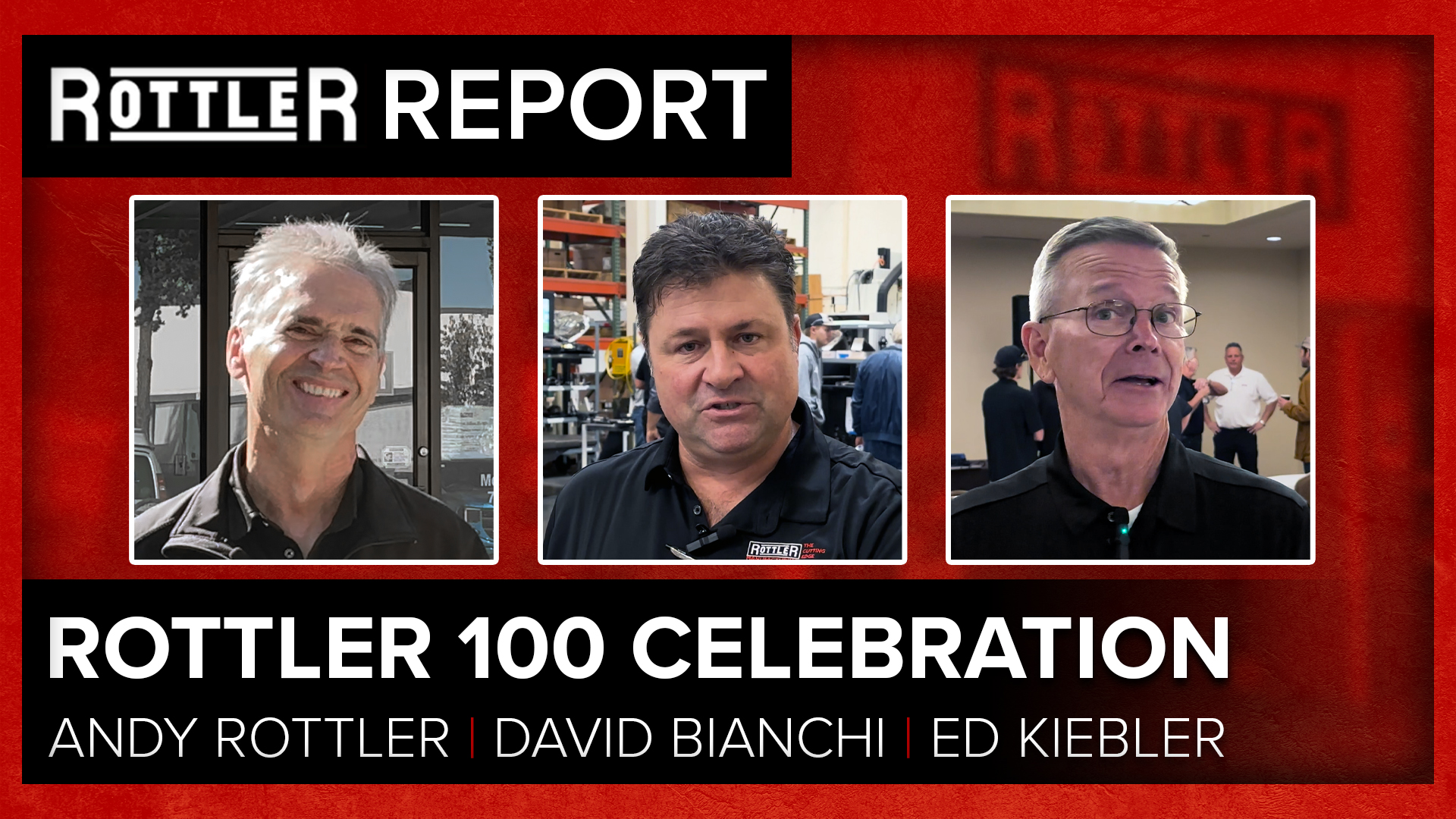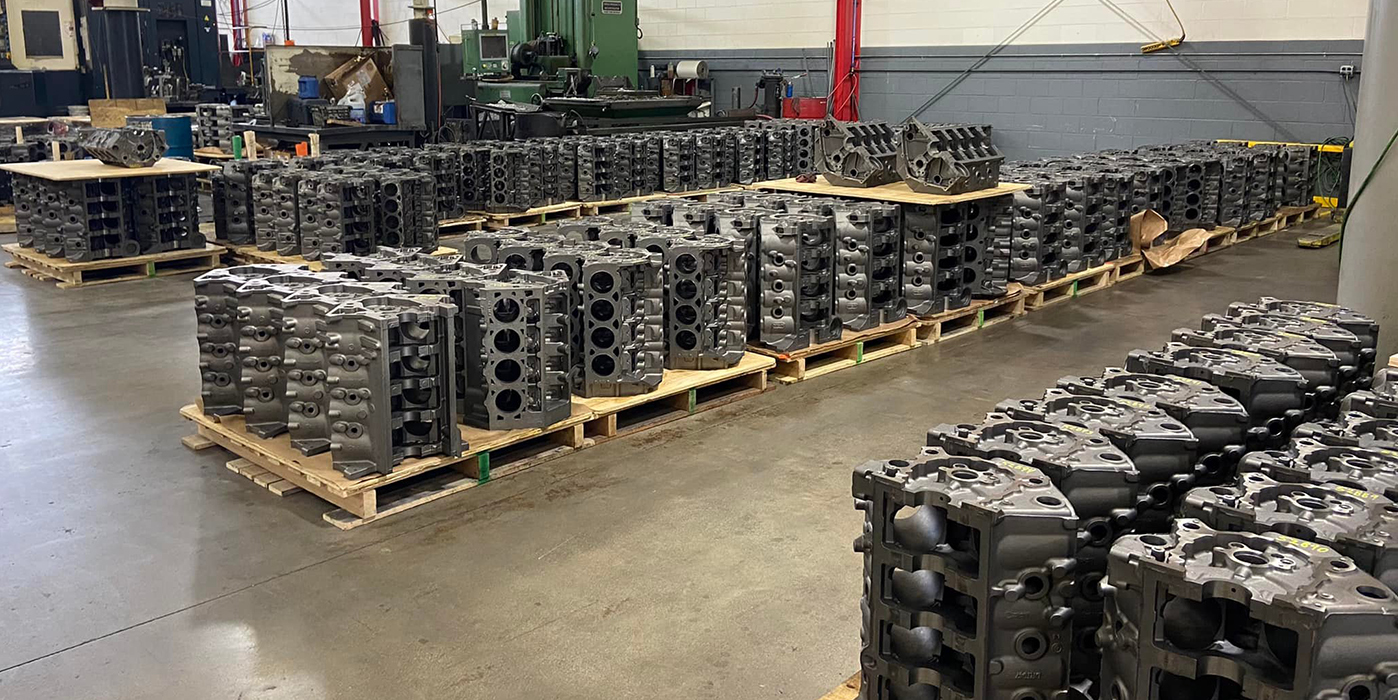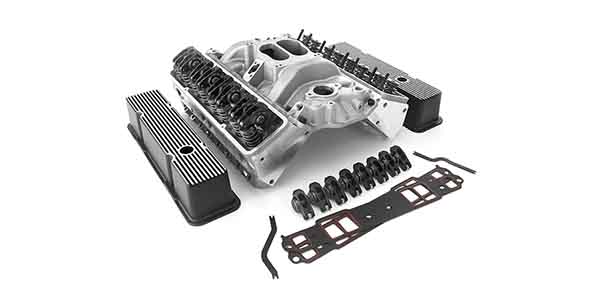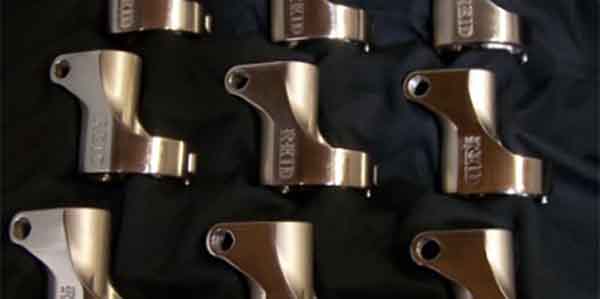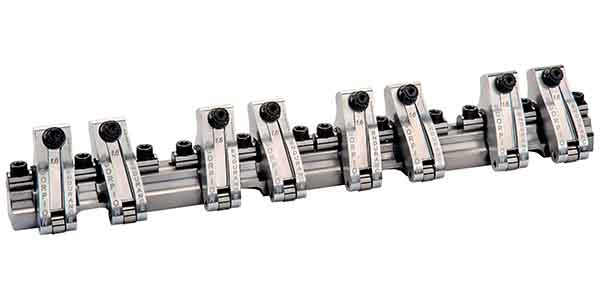The upper valvetrain is one of the most critical components in an engine build, so it’s essential you choose the right parts for the application and install them correctly. Here are some suggestions for getting things right:
DON’T USE “STANDARD” LENGTH PUSHRODS
Many variables can affect the length of the pushrods that are required to achieve correct rocker arm geometry. Standard length pushrods are fine for stock engines with stock cams, lifters, rockers and valves – as long as the valves are at the stock installed height and are not recessed into the head due to seat wear or re-facing. But once any of these variables change, so does rocker arm geometry.
Replacing a stock cam with a performance cam, changing from flat tappets to roller lifters, installing roller rockers or high lift rocker arms, changing from stud mount to shaft mount rockers, or using different length valve stems will change rocker geometry and pushrod length. Replacing stock cast iron heads with aftermarket aluminum heads, or switching from a cast iron block to an aluminum block can sometimes alter valvetrain geometry. Some aftermarket aluminum performance blocks have a taller deck and raised cam location that will require different length pushrods. The same goes for racing blocks that accept big bore cams with larger cam lobes. Some aftermarket performance heads have different valve angles and may be engineered for a different type of rocker system, which will also require different length pushrods.
Even something as simple as replacing a stock cam with a performance cam will change pushrod length. The base circle of the cam lobes on a performance cam are usually ground to a smaller diameter so the lobes can provide more total lift. This, in turn, causes the lifters to ride lower in their bores, which requires longer pushrods to compensate for the change in valvetrain geometry.
If a really high lift cam is being installed along with valves that have longer stems to accommodate the increased lift, that will also change rocker geometry and require different length pushrods. If a flat tappet cam is being replaced with a roller cam, the lifters may be taller and require shorter pushrods.
Installed valve height also influences rocker geometry. Remachining worn valve seats will cause the valves to set lower in the head and the stems to protrude higher above their spring seats. The increase in installed valve height will reduce spring pressure, so shims under the springs are required to compensate for the change in valve height. But because the tip of the valve is now in a higher location than before, it tilts the rocker up slightly and alters rocker geometry. To maintain the same geometry as before, the position of the rocker needs to be raised an equivalent amount. With a stud mount rocker, this is done with a longer pushrod. With shaft mount rockers, installing shims under the shaft stands can raise the rockers – which will then require longer pushrods too.
Pushrod length is critical because it affects the positioning of the rocker arms relative to the valves. The tips of the rockers follow an arc that depends on the fulcrum point of the rocker, rocker offset and lift ratio. Anything that changes this geometry can have an effect of valve lift and duration. It can also increase side loads on the valve stems, friction and guide wear.
With some shaft mount rocker systems, the alignment of the rockers, pushrods and pushrod adjusters can affect oil flow to the rockers and valves. If the pushrods are too long or too short, or the pushrod adjusters are turned too far one way or the other, it may tilt the rockers too far in one direction and partially obstruct oil flow. Overextending the adjusters may also lead to breakage of the adjuster or rocker failure.
DON’T GUESS WHEN CHOOSING A PUSHROD LENGTH
Off-the-shelf pushrods are available in various lengths, often in .025˝ or .050˝ increments to fit various applications and accommodate modifications to the valvetrain. Close enough may be okay for a street performance motor but not for a serious racing engine. You need pushrods that are the exact length to achieve correct rocker geometry. for these builds, custom length pushrods that are made to order are available.
The only way to know for sure how long the pushrods should be is to use an adjustable pushrod. An adjustable pushrod can be lengthened or shortened as needed to determine the best fit.
To determine pushrod length, install the adjustable pushrod like an ordinary pushrod in the assembled engine (head bolted to the block with the rockers in place). Use a light valve spring or a single spring to hold the valve shut. Set valve lash to the desired amount. With hydraulic lifters, that would be zero lash with a slight preload on the lifters. Then check the alignment of the tip of the rocker arm with the top of the valve stem.
By changing the length of the pushrod, you can realign the position of a stud mount rocker and move the point of contact where the tip of the rocker touches the top of the valve in or out. What you are trying to accomplish is position the tip of the rocker so that it slides back and forth more or less over the center of the valve. Actual rocker geometry will depend on the relative position and height of the rocker to the valve stem when the valve is closed, the rocker ratio, the design of the rocker arm and the arc the tip of the rocker follows as it opens and closes the valve.
To check the alignment, color the tip of the valve stem with a black dry marker, then turn the engine over several times to see where the tip of the rocker actually rubs on the valve.
As a general rule, the area where the tip of the rocker rubs across the top of the valve stem should be centered over the valve and as narrow as possible. When the valve is closed, the tip of the rocker is usually offset slightly from the center of the valve toward the intake side of the head. As the valve opens, the tip of the rocker slides across the top of the valve and moves towards the exhaust side of the head.
You can experiment with the contact pattern by changing the length of the pushrods. If the pushrod is too long, the pattern may be too wide and offset towards the exhaust side of the head. If the pushrod is too short, the pattern will again be too wide but offset towards the intake side of the head.
Experts disagree about how much offset is acceptable for a given rocker arm system, but most agree that too much offset can be detrimental because of increased friction and side loading on the valves and guides. The tip of the rocker should never come closer than .020˝ from the edge of the valve stem.
Once you’ve found the sweet spot for your rockers, the next step is to remove the adjustable pushrod and measure its length. Methods of measurement will vary so make sure you are using the same method as your pushrod supplier. With a cup style pushrod, measure from the bottom of the cup (insert a ball bearing into the cup, then subtract its diameter) to the tip of the pushrod. With pushrods that have balls on both ends, measure end to end. Some pushrod suppliers also want you to compensate for the hole radius in the end of the pushrod.
It’s a good idea to measure pushrod length separately for intake and exhaust valves and to check the valves on a couple of different cylinders to make sure everything is the same.
GO STRONG – DON’T
USE WIMPY PUSHRODS
Pushrods have to overcome the spring pressure created by the valve springs. On a stock motor with single valve springs, it’s not a lot of pressure so thin wall, lightweight pushrods can usually handle the job. But on a performance engine with double or triple springs and high lift cams/rockers, the pushrods may have to overcome 500 to 1,200 lbs. of pressure depending on the setup. Obviously, stock pushrods would hold up like limp spaghetti in such an application, so upgrading the pushrods would be an absolute must.
Pushrod flex at high RPMs and loads can reduce valve lift and duration, and if the rods flex enough they can permanently bend. Pushrod flex can also create a “pole vault” effect at high RPM causing the valves to exceed their normal lift – which may lead to valve spring coil bind issues, contact between the spring retainers and guides, or valve-to-piston contact.
You want stiffer, stronger pushrods, which means pushrods with thicker walls, a stronger alloy steel, and/or a larger outside diameter. Larger diameter pushrods and ones with thicker walls provide much greater strength and rigidity. Tapered pushrods or even solid pushrods provide the ultimate in strength. Yes, there is a slight weight penalty with beefier pushrods but the weight has much less effect on valvetrain momentum than weight on the valve side of the rocker.
If you want to improve valvetrain stability, lighten up the valve side of the system with beehive springs or conical springs. These springs are lighter than standard coil springs due to their reduced upper diameter, and are less prone to harmonics that cause instability at higher engine speeds. Beehive and conical springs also require smaller diameter (and much lighter) retainers. Many tool steel retainers are as light or lighter than titanium retailers. Such weight savings can more than offset any weight gains on the pushrod side of the rockers.
DON’T OVERSPRING
THE VALVES
If 130 lbs. of closed valve seat pressure is good, then 300 lbs. must be even better, right? Likewise, if double springs are better than single springs, then triple springs really must be the way to go. Despite what you may hear, bigger isn’t always better. Stiff springs are better than stock springs – if the engine really needs them. But sometimes there is a tendency to go overboard with spring pressure. Too much of a good thing can actually be a bad thing.
Triple springs are the way to go if you’re building a ProStock drag motor that will rev beyond 10,000 RPM, but for engines that never see the high side of 7,000 to 7,500 RPM, a good set of quality beehive or conical springs can usually provide the best valve control with the least load on the rockers, pushrods, lifters and cam.
Double springs provide a margin of safety if one of the springs breaks. But if you buy quality springs made from high quality steel, breakage should not be an issue. Various surface treatments as well as cryogenic processing can also extend spring life and reduce the risk of breakage.
Ideally, you want the least amount of valve spring pressure that will provide adequate valvetrain stability and control within the RPM limits of the engine. Excessive spring pressure accomplishes nothing except increased friction, loading and stress on the rockers, pushrods, lifters and cam.
DON’T ASSUME
ALL CLEARANCES
ARE CORRECT
Anytime you change components there is a risk of mismatched parts or interference problems. One item that should always be checked with high lift cams is valve spring retainer to valve guide clearance. Allow a minimum of .060˝ of clearance to prevent contact.
Another item to check is valve spring coil clearance at maximum valve lift. Again, there should be .060˝ of clearance between the coils so the springs don’t bind. If there is insufficient clearance, you’ll bend a pushrod or break a rocker.
The slots in stud mount rockers need to be checked to make sure there is adequate clearance between the slot and stud at maximum valve lift. Also, make sure the pushrods are not rubbing against the head or guide plate (if used) at maximum valve lift. Pushrods generally need about .010˝ of clearance.
Valve-to-piston clearance should also be checked with high lift cams and rockers to make sure the reliefs in the pistons are adequate to clear the valves.
DON’T ASSUME THE PARTS ARE CORRECT
Mistakes happen and sometimes the wrong parts are shipped or are mismatched with other parts. Valve spring retainers and locks are a prime example of where mix-ups can occur. There are 10-degree locks and retainers, but also 7-degree locks and retainers. Mix them up and you could have a retainer or valve failure.
More often than not, most fitment issues arise when the wrong parts are ordered. They don’t fit the application because they are not the correct parts for that application. If you are not sure which rockers, springs or pushrods to order, talk with your supplier and give them as much information as they need to figure out which parts are the right ones for the motor you are building.
And even if everything bolts together properly and there appear to be no interference problems, no professional engine builder should ever assume cam timing, lift and duration are as specified. Always use a degree wheel and dial indicator to check and verify cam timing and lift.
YOU GET WHAT
YOU PAY FOR
Everybody loves a bargain, so if a price seems to be too good to be true, there’s probably a reason why. The aftermarket has been flooded with cheap knock-offs and low quality engine parts from no-name offshore suppliers, including various valvetrain components. Many of these products look the same as name-brand components, or they may even be counterfeit parts that appear to be a name-brand product.
The problem with the cheap knock-offs is that they often lack the metallurgy, strength, durability and reliability of the brand name quality parts they are underselling. Metallurgy is an exact science, and if a low-buck supplier lacks the expertise in this critical area (or cuts corners to reduce their manufacturing costs), the result will be an inferior product that won’t hold up.
Cast aluminum rockers are a good upgrade over stock stamped steel or powder metal rockers for many street performance applications. But cast rockers are not as strong as extruded, forged or CNC billet aluminum rockers, or steel rockers. Each type of product is designed for a certain type of application, ranging from low budget street performance to high end professional racing. You can’t substitute one for the other and expect to get the same results.
Follow your supplier’s recommendations as to what type of rocker to use on a given engine build. They know their stuff and can tell you which of their products will best provide the durability and performance you are looking for. The hot setup for a race motor might be to run steel rockers on the exhaust valves and forged or billet aluminum rockers on the intakes.
DON’T THROW AWAY THE INSTRUCTIONS!
The last bit of advice we will offer in this article on upper valvetrain components is don’t throw away the instructions that come with the parts – even if you’ve used the same parts before on a similar engine build. Things can change and there may be special steps required to properly set up the valvetrain.
With some shaft mount rockers systems, for example, adjusting the height of the rocker shaft may require using a special gauge. If you miss that critical step, you might end up with less than ideal rocker geometry and problems down the road. ν
For valvetrain supplier contact information, use our interactive online Buyers Guide resource at
www.enginebuildermag.com.






